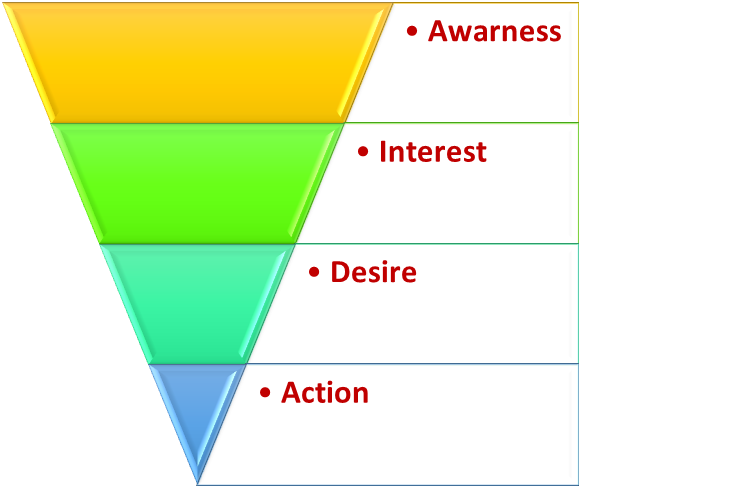AIDA Model is a classic marketing framework that outlines the cognitive stages a consumer goes through during the buying process. It stands for Attention, Interest, Desire, and Action. Initially, it aims to capture the Attention of the target audience through various marketing and advertising efforts. Once attention is secured, the goal shifts to generating Interest in the product or service by highlighting its benefits and features. This interest is then nurtured into Desire, where consumers develop a keen inclination or wish to acquire the product. Finally, the model seeks to motivate the consumer to take Action, which involves making a purchase decision. The AIDA model is widely used in marketing to guide the creation of effective advertising and promotional strategies.

A – Attention (or Awareness)
The first step involves capturing the potential customer’s attention or making them aware of a product or service. In a world saturated with information and advertising, standing out and grabbing consumer attention is critical.
- Strategies:
This can be achieved through various means such as eye-catching advertising, social media presence, public relations efforts, or any form of exposure that can make the target audience notice the brand or product.
I – Interest
Once the attention of the potential customer is captured, the next step is to pique their interest. At this stage, the consumer starts to express an interest in the product or service and wants to learn more about it.
- Strategies:
Marketers can foster this interest by providing engaging and relevant information that resonates with the audience’s needs, desires, or pain points. Content marketing, detailed product descriptions, engaging visuals, and informative videos are effective tools at this stage.
D – Desire
Moving beyond mere interest, the Desire stage is where consumers develop a specific attraction towards the product or service. It’s about creating an emotional connection, making the consumer feel like they want or need the product.
- Strategies:
This can be achieved by highlighting the benefits and features that set the product apart from competitors, customer testimonials, and showcasing the product’s ability to solve a problem or improve the consumer’s life in some way.
A – Action
The final stage involves persuading the customer to take a specific action, such as making a purchase, signing up for a newsletter, or any other goal of the marketing campaign. It’s where interest and desire convert into a decision.
- Strategies:
To encourage action, marketers can use clear and compelling calls-to-action (CTAs), offer limited-time promotions or discounts, provide easy access to the purchase process, and ensure a smooth and hassle-free checkout experience.
Benefits of the AIDA Model
- Structured Approach:
AIDA provides a clear, step-by-step framework that helps marketers plan and execute their campaigns systematically, ensuring that no aspect of the consumer’s journey is overlooked.
-
Enhances Creativity:
By requiring attention to each stage—Attention, Interest, Desire, Action—AIDA encourages marketers to think creatively about how to engage consumers at every step, leading to innovative and effective marketing strategies.
-
Improves Targeting:
Understanding the stages allows marketers to tailor their messages and channels more effectively to reach their audience at the right time with the right content, thus improving the efficiency of marketing efforts.
-
Facilitates Measurement:
Each stage of the AIDA model offers specific outcomes that can be measured, allowing marketers to evaluate the performance of their campaigns and adjust strategies for better results.
-
Customer-Centric:
The model emphasizes understanding and responding to the needs and desires of the consumer, leading to more customer-focused marketing that is more likely to resonate and drive conversions.
Challenges of the AIDA Model
-
Linear Process Assumption:
AIDA suggests a linear journey, but consumer decision-making is often non-linear, with individuals moving back and forth between stages or skipping stages entirely, especially in the digital age.
-
Changing Media Landscape:
The proliferation of digital channels and platforms complicates how consumers receive and interact with marketing messages, making it more challenging to capture attention and maintain interest through traditional methods.
-
Consumer Skepticism:
In an era of information overload, consumers have become more skeptical of advertising and marketing messages. Generating genuine interest and desire requires more sophisticated and authentic engagement strategies.
-
Measurement Complexity:
While the AIDA model facilitates measurement, accurately assessing emotional engagement and attributing actions to specific stages can be challenging, particularly with multiple touchpoints and channels involved.
-
Ignoring Post-Purchase Behavior:
AIDA focuses on leading up to the action (purchase), but it does not address post-purchase satisfaction, loyalty, or advocacy, which are crucial for long-term brand success.
One thought on “AIDA Model, Components, Benefits and Challenges”